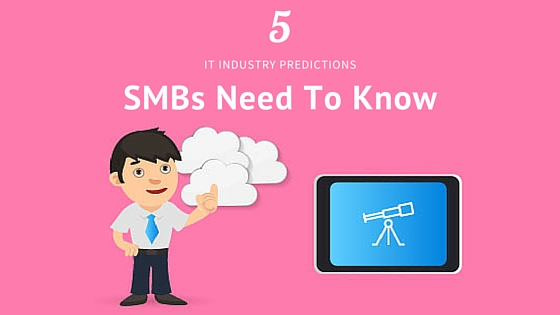5 IT Industry Predictions SMBS Need To Know
The growth of the IT landscape know no limits; the rate at which new technologies grace the market present new opportunities for SMBs to benefit from cost-effective solutions and to develop new competitive advantages. The dynamics of the IT market change at considerable proportions, which is why CIOs and IT managers need to give utmost attention to embrace new enterprise technologies and anticipate industry predictions that can shape the course of IT practices in years to come.
Over the past few years, SMBs have harnessed the power of cloud computing, data analytics, and marketing automation systems, and incorporated various IT strategies. But, given the pressures of competitive rivalry and lower project deployment costs, the race to obtain the most cost-effective solution to drive organizational efficiency will always remain a key concern.
For this reason, we present the top 5 IT industry predictions every SMB needs to know about.
Cloud Transformation
2015 was dubbed as the year of the cloud and for good reason; cloud spending last year reached $100 billion according to Synergie, and the chances of this exponential rise to continue in subsequent years seem plausible.
However, SMBs do not need to adopt the cloud just for the sake of increasing business efficiency. Instead, they need to move beyond mastering cloud implementation and focus on new areas to be able to create and sustain their competitive advantages to drive higher business growth. The cloud, therefore, is undergoing changes, and only firms that are able to adjust to these dynamics will emerge triumphant in the market.
One of these changes is the rise of the internet of things (IoT). These refer to interconnected networks of mobile and digital devices that have tremendous potential for catapulting marketing, customer service, and other management practices to a whole new level.
Due to the use of wireless technologies, IoT can enable SMBs to save considerably in installation and maintenance cost, along with overheads. The anticipated transition to Li-Fi will also entail faster device deployment capabilities, rendering it a critical part in faster and simplified business processes.
Another instrument shaping the cloud is the increase in mobile as a platform. Consumers are already spending a significant proportion of their time on web activities, such as browsing search engine results websites, and e-mails from the comfort of their mobile phones. Smart Insights highlights that media time spent using the mobile device outstrip that using the desktop. This has huge potential for mobile marketing that is already starting to culminate in the guise of higher enterprise mobile application development initiatives using cloud models, such as SaaS and PaaS.
Hybrid Infrastructure
The combined advantages of both private and public cloud networks are leading to a rise in demand for hybrid cloud infrastructures. Gartner expects hybrid infrastructures to be used by half of all enterprises by 2017 despite being a rare occurrence at the moment.
At the moment, businesses are resorting to private cloud due to the advantages of faster deployment and adjustment. But, the advantages of greater compatibility of the public mean that there is a move towards balancing both speed and compatibility, in addition to cost reduction. Companies that opt for hybrid models are able to effectively control large data workloads and utilize network storage capabilities that allow them to drive higher productivity and output.
Machine learning algorithms
Machine learning algorithms are another area that is expected to bring unprecedented opportunities for bolstering enterprise security and business process improvements. The algorithms have a self-learning capability, which means that are immensely beneficial for performing data analytics functions, such as using predictive analytics and text analytics.
Machine learning employs pattern recognition technologies that can set a new benchmark in enterprise security solutions. The growing threat of cyber attacks and data breaches can be effectively mitigated if machine learning algorithms are implemented. This will be pivotal for managing data risk management applications and decision-making, enabling SMBs to conduct business operations with greater confidence.
Data Management
With the emphasis placed on Big Data analytics and cloud data storage, the importance of data management in balancing the need for analytics and efficient data utilization is one that is expected to culminate in various solutions in the future. While data analytics is highly crucial for small businesses to be able to extract meaningful insights to aid business decisions, the risks of monstrous amounts of data can factor into immense complexity and time-consuming activities.
So much so that companies that employ big-data applications are facing a shortage of big data talent that can pinpoint relevant data out of a universe of data. Therefore, there is an overwhelming need to control the pace at which companies can interact, process, and utilize data. Data management solutions will enable businesses to reduce the amount of time taken to gather, validate, and assess data for business decisions.
Open Source
This is another trend that is expected to gain widespread traction. It seems that the development of open source technologies such as Linux OS and the Apache server have finally caught on with enterprises in the 21st century. The growth in software-as-a-service cloud models are presenting new found uses for open source and is anticipated to be a key innovation for governments. The benefits of open source are giving businesses incredible flexibility in adjusting applications to their own business requirements. Considering the success of Apache in gaining market share in a consistent manner and dominating the World Wide Web, many will be keen on extrapolating its success for their own corporate goals.
This will lead to new business models, such as Red Hat, a company that hosts a version similar to Linux OS across a network of users. Businesses can download codes for free and any upgrades are managed by the provider.


